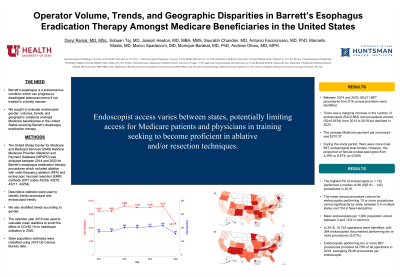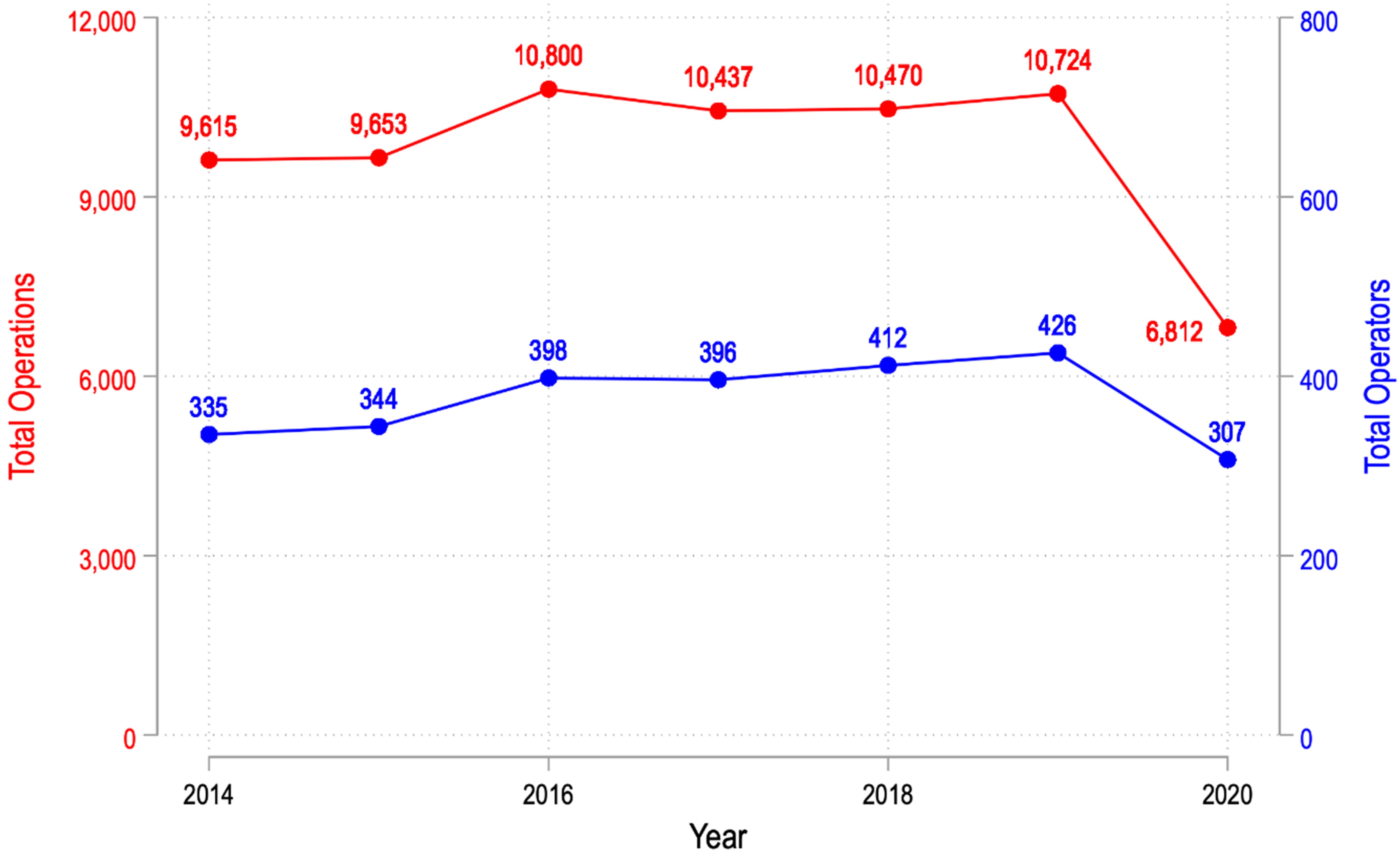Tuesday Poster Session
Category: Esophagus
P3275 - Operator Volume, Trends, and Geographic Disparities in Barrett’s Esophagus Eradication Therapy Amongst Medicare Beneficiaries in the United States
Tuesday, October 24, 2023
10:30 AM - 4:00 PM PT
Location: Exhibit Hall


Daryl Ramai, MD, MSc
University of Utah
Salt Lake City, UT
Presenting Author(s)
Daryl Ramai, MD, MSc1, Sobaan Taj, MD2, Joseph Heaton, MD3, Saurabh Chandan, MD4, Antonio Facciorusso, MD5, Andrew Ofosu, MD, MPH6
1University of Utah, Salt Lake City, UT; 2Hackensack Meridian Jersey Shore University Medical Center, Neptune, NJ; 3Jersey Shore University Medical Center, Neptune, NJ; 4Creighton University School of Medicine, Omaha, NE; 5University of Foggia, Foggia, Italy, Neptune, NJ; 6UC Medical Center, Cincinnati, OH
Introduction: The World Endoscopy Organization has defined Barrett’s endoscopic therapy (BET) as the eradication of dysplastic BE or intramucosal cancer by tissue resection and or ablation during endoscopy. Endoscopic resection is indicated for raised superficial lesions, followed by ablation of the remaining Barrett’s segment. The goal of endoscopic ablation is to completely eradicate intestinal metaplasia to prevent the development of cancer, which should correlate with a decrease in esophagectomy rates. However, there is limited real-world data examining access to BET. We sought to evaluate Barret’s esophagus eradication therapy operator volumes, trends, and geographic variations amongst Medicare beneficiaries in the United States.
Methods: The United States Center for Medicare and Medicaid Services (CMS) National Medicare Provider Utilization and Payment Database (MPUPD) was analyzed between 2014 and 2020 for Barret’s esophagus eradication therapy procedures. Descriptive statistics were used to identify trends procedural and operator trends. The calendar year 2019 was used to calculate mean statistics to avoid the effect of COVID-19 on healthcare utilization in 2020. State population estimates were classified using 2019 US Census Bureau data.
Results: Between 2014 and 2020, 68,511 BET procedures from 818 unique providers were identified. There was a marginal increase in the number of operators (R2=0.883) and procedural volume (R2=0.6104) from 2014 to 2019, but declined in 2020. Yearly trends in total operation volume and operatory quantity are provided in Figure 1. The average Medicare payment per procedure was $210.37. The highest 5% of operators (n = 19) performed a median of 96 (IQR 81 – 142) procedures in 2019. The mean annual procedure volume for operators performing 10 or more procedures varied significantly by state, between 0 in multiple states and 104 in New Hampshire (Table 1). Mean operators per 1,000 population varied between 0 and 15.6 in Vermont. In 2019, 10,724 operations were identified, with 364 operators documented performing ten or more procedures (5.07%). Operators performing ten or more BET procedures provided 34.79% of all operations in 2019, averaging 29.46 procedures per operator.
Discussion: Our data showed a significant decline in Barret’s esophagus eradication therapy in 2020, likely due to COVID-19. It is unclear regarding the optimal balance of procedural requirements to sustain high efficacy outcomes and ensure critical access to Barret’s esophagus eradication therapy.

Disclosures:
Daryl Ramai, MD, MSc1, Sobaan Taj, MD2, Joseph Heaton, MD3, Saurabh Chandan, MD4, Antonio Facciorusso, MD5, Andrew Ofosu, MD, MPH6. P3275 - Operator Volume, Trends, and Geographic Disparities in Barrett’s Esophagus Eradication Therapy Amongst Medicare Beneficiaries in the United States, ACG 2023 Annual Scientific Meeting Abstracts. Vancouver, BC, Canada: American College of Gastroenterology.
1University of Utah, Salt Lake City, UT; 2Hackensack Meridian Jersey Shore University Medical Center, Neptune, NJ; 3Jersey Shore University Medical Center, Neptune, NJ; 4Creighton University School of Medicine, Omaha, NE; 5University of Foggia, Foggia, Italy, Neptune, NJ; 6UC Medical Center, Cincinnati, OH
Introduction: The World Endoscopy Organization has defined Barrett’s endoscopic therapy (BET) as the eradication of dysplastic BE or intramucosal cancer by tissue resection and or ablation during endoscopy. Endoscopic resection is indicated for raised superficial lesions, followed by ablation of the remaining Barrett’s segment. The goal of endoscopic ablation is to completely eradicate intestinal metaplasia to prevent the development of cancer, which should correlate with a decrease in esophagectomy rates. However, there is limited real-world data examining access to BET. We sought to evaluate Barret’s esophagus eradication therapy operator volumes, trends, and geographic variations amongst Medicare beneficiaries in the United States.
Methods: The United States Center for Medicare and Medicaid Services (CMS) National Medicare Provider Utilization and Payment Database (MPUPD) was analyzed between 2014 and 2020 for Barret’s esophagus eradication therapy procedures. Descriptive statistics were used to identify trends procedural and operator trends. The calendar year 2019 was used to calculate mean statistics to avoid the effect of COVID-19 on healthcare utilization in 2020. State population estimates were classified using 2019 US Census Bureau data.
Results: Between 2014 and 2020, 68,511 BET procedures from 818 unique providers were identified. There was a marginal increase in the number of operators (R2=0.883) and procedural volume (R2=0.6104) from 2014 to 2019, but declined in 2020. Yearly trends in total operation volume and operatory quantity are provided in Figure 1. The average Medicare payment per procedure was $210.37. The highest 5% of operators (n = 19) performed a median of 96 (IQR 81 – 142) procedures in 2019. The mean annual procedure volume for operators performing 10 or more procedures varied significantly by state, between 0 in multiple states and 104 in New Hampshire (Table 1). Mean operators per 1,000 population varied between 0 and 15.6 in Vermont. In 2019, 10,724 operations were identified, with 364 operators documented performing ten or more procedures (5.07%). Operators performing ten or more BET procedures provided 34.79% of all operations in 2019, averaging 29.46 procedures per operator.
Discussion: Our data showed a significant decline in Barret’s esophagus eradication therapy in 2020, likely due to COVID-19. It is unclear regarding the optimal balance of procedural requirements to sustain high efficacy outcomes and ensure critical access to Barret’s esophagus eradication therapy.

Figure: Yearly Trends of Barrett’s endoscopic therapy. Red line: number of procedures. Blue line: number of operators performing at least 10 procedures minimum.
Disclosures:
Daryl Ramai indicated no relevant financial relationships.
Sobaan Taj indicated no relevant financial relationships.
Joseph Heaton indicated no relevant financial relationships.
Saurabh Chandan indicated no relevant financial relationships.
Antonio Facciorusso indicated no relevant financial relationships.
Andrew Ofosu indicated no relevant financial relationships.
Daryl Ramai, MD, MSc1, Sobaan Taj, MD2, Joseph Heaton, MD3, Saurabh Chandan, MD4, Antonio Facciorusso, MD5, Andrew Ofosu, MD, MPH6. P3275 - Operator Volume, Trends, and Geographic Disparities in Barrett’s Esophagus Eradication Therapy Amongst Medicare Beneficiaries in the United States, ACG 2023 Annual Scientific Meeting Abstracts. Vancouver, BC, Canada: American College of Gastroenterology.
